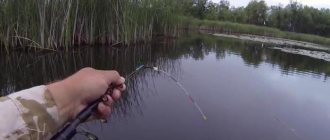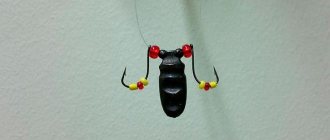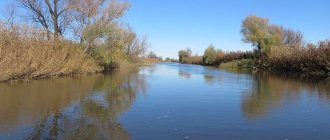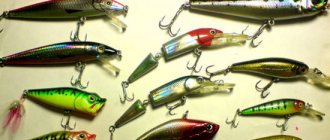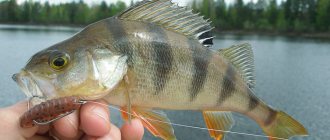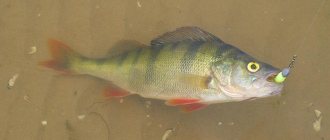What parts are used to make the tackle?
When fishing for perch on a bulldozer, you use a short fishing rod, the end of which is reinforced with hard material, which helps you play the bait in the right directions. A soft nod on the rod in the form of a silicone tube registers the moment when the rod touches the bottom and records the bite. When using one tool, but at different depths of water, it is equipped with a device for winding and unwinding fishing line onto a plastic reel. You can build a boom yourself; this tackle is simple in design and does not require special skill to install the elements.
Materials are selected from household items or purchased at a retail outlet:
- the lead weight is elongated in shape, resembling a drop with a drilled hole in the narrowed part;
- 2 identical hooks placed on the sides of the sinker on the fishing line; for this, tie a loop;
- bright beads , multi-colored fragments of a plastic tube that has elasticity and flexibility.
Hooks are selected smaller in size than the attached load with the points directed in different directions. The fisherman selects tackle in accordance with the parameters of the perches that live in a given reservoir; if the fish is small, a small one is attached and vice versa. Beads are strung on each hook and decorated with colored cambrics.
Painted in colors:
- black
- brown
- green
Experiments can be different with coating the lower part of the bulldozer in a red tint or leaving it in its original form, since the paint doesn’t last long anyway. Each master observes the preference of the perch and decides how to modify the bass. They figure out how best to attach the hooks, build a sinker that is not lead, but:
- tungsten
- bronze
- copper
Each fisherman has his own differences in making the shape of the bulldozer. The lower part of it is sealed, filling the middle with metal balls, causing the bulldozer to rattle. The device can cause a bell effect if a fishing line with a ball from a small bearing is passed through a hole made throughout the body of the sinker. Various additions to the bait increase the number of bites.
Watch a video about underwater filming of perch fishing.
How to catch perch in winter
Not every fish is suitable for winter fishing for perch. If you make it yourself, you can make it according to the basic requirements. But, if you buy tackle in a store, you should know what criteria to select it by (Figure 3).
The bait is chosen taking into account the following features:
- Color: A quality weight should be colored black, brown or dark green, with the bottom red. However, it should be taken into account that in most cases, weights are made of lead, and due to constant contact with water, the paint on it regularly peels off, so even a high-quality weight will have to be periodically tinted.
- Shape: can be arbitrary, depending on the preferences of the fisherman. As a rule, only the weight itself and the place where the hooks are attached change. In some cases, the bulldozer is additionally equipped with a rattle to attract fish. To increase the number of bites, some fishermen equip the bulldozer with a fishing line with a small ball that acts like a bell.
- Weight: according to this criterion, the bait is selected depending on the depth of the reservoir itself. The universal bulldozer weighs 10 grams and is approximately 5 cm in length. The hooks chosen are classic ones, with the number 15.

Taking into account these criteria, you can easily select a bait for catching perch in winter.
But, if you want to get a bait that fully suits your preferences, it is better to make it yourself.
We improve, we experiment
You can change the type of gear using any of the following methods. All of them are united by the method of fixing hooks with loads.
Bait can be used in different ways:
- A device threaded onto a loop. The location of the hooks is installed on the sides of the main body, they move freely, a certain size is provided for the ring so that parts do not get caught between each other.
- The fishing line is soldered into the upper part of the sinker, hooks are attached to its loops, and the entire structure is completely immersed in the silt.
- Fishing in open waters is possible by throwing a spinning rod into a coastal hole, pulling up and tapping the bottom.
- Using bits of different lengths allows you to examine the bottom in winter and catch perch from a bridge or pier.
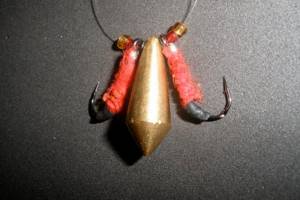
Consider some properties of the bait:
- a design consisting of single hooks on the sides of the load at the moment of contact with the bottom will raise turbidity, sharp ends with multi-colored objects move after the body has stopped, which attracts perches to bite;
- the main part of the canopy is made of different shapes - cone-shaped, cylindrical, spherical, differs in weight, this parameter depends on the depths of the reservoirs and at what speed the river flows;
- To attract perch, the sinker is made with edges.
Types of bulldozer:
- universal, weighted hooks are connected to a triple swivel, where the main fishing line is tied;
- Bronze, brass, and copper tackles call perches with their sound;
- the body of the load is not drilled with a hole, but a ring is attached;
- a structure consisting of three hooks, one of which is fixed from below, beads are added between all the elements.
☸ Fishing technique
The performance of this versatile bait depends on what fish it is aimed at in each particular case. For a predatory animal the animation is one, for a peaceful one it is completely different. Let's consider fishing options for catching the most active species in winter.
⚓ Perch
Hunting for striped fish is a popular sport fishing, interesting for many amateur fishermen. You definitely won’t freeze on it, because you have to constantly move around the reservoir in search of the object of fishing. The “perch” game is perhaps the simplest. After the first touch to the bottom, the fisherman tightens the tackle, keeping the nod half-bent, and then begins to methodically and sharply throw the bait up to a height of 20 cm. At the lowest point there is a short pause. There is no point in swinging a fishing rod over one hole for hours; if 10-12 throws do not bring results, you can move on to the next one.
⚓ Pike perch
The winter bait Balda works great against fanged predators. Successful pike-perch fishermen, of course, try to keep the technique they’ve developed over the years secret, but newcomers sitting next to them still manage to spy on it and copy it. The following sequence of actions is recognized as the most effective in fishing for pike perch with a canard: several strong blows of the bait on the bottom surface (to raise more mud), rise by 15 cm, return to the bottom, pause for a few seconds and rise again. If there are no bites for a long time, it is better to move and try to fish another hole.
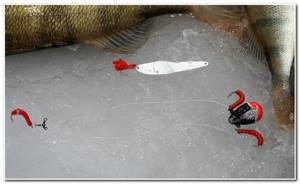
⚓ Pike
The pike fishing pole differs somewhat from the classic version, primarily in the size of the hooks, as well as the weight and shape of the sinker. It should be slightly flattened and fall on its side after touching the bottom. In addition, it is possible to catch predators with a combined rig, in which the function of a sinker is performed by a “devil” with three hooks. You can provoke a pike to bite like this: tap the bait on the bottom, smoothly lift it 30 cm and, after a short pause, sharply throw it down.
⚓ Bream
Catching a large bream in winter is the cherished dream of most anglers, and the bulldozer often helps make it come true. To increase the chances of success, in addition to the kebriks, you can attach several maggot or bloodworm larvae to the hooks. Unlike fishing for predators, bream needs to be served slowly and slowly. Sudden movements and high-speed climbs are inappropriate here. Often he grabs the bait when it lies motionless on the bottom surface.
What is the advantage of bait
Perch fishing has proven to be good in places clogged with snags, where it is impossible to use a spoon.
The method with this bait has the following positive aspects:
- Since the load is endowed with a certain weight, which pulls the bait down, it easily reaches the limit and does not cling to the edges.
- The depth of the river and its current do not affect the bulldozer; it achieves its purpose of attracting attention.
- For bait, you do not need to waste time on the bait, since its hooks are lowered with decoration; they stimulate the appetite of the perches by simulating food with their movement.
- Lightly tapping the cannon on the ground gets the perches excited and they become active.
Whatever fish falls for this eccentric bait, the bulldozer is considered to be aimed only at perch, regardless of whether it is coastal or deep. To regulate fishing, use a weight to reduce or decrease its mass.
☸ Tackle for fishing on the bulldozer
The bait does not require the use of any unusual and expensive winter fishing rods. The fishing rod for fishing on ice can be anything, but most often it is an ordinary balalaika with a hard nod, since its sensitivity is not particularly important. The bites are perfectly transmitted to the hand due to the weight of the bait. Wiring is done exclusively with a rigid six, and the nod is needed only to record touching the bottom. There are also no separate recommendations regarding fishing line. It can be either braided or monofilament, everyone chooses according to their preferences. The main thing is not to be afraid of cliffs and use a line commensurate with the expected catch and the weight of the bait itself. For example, for catching small perch weighing up to 300 g, a monofilament fishing line with a cross-section of 0.14 mm is suitable, but if a pike bite is possible, then the diameter should be increased accordingly.
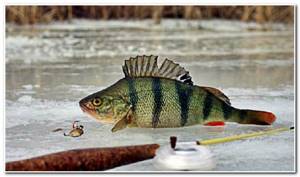
Where and when to look for perch
In the middle of the winter period, the perch will become capricious and will not be caught on jigs and spinners; the most effective way to catch it is with a bulldozer. With its help, you can fish every recess and force the fish to respond to the bait.
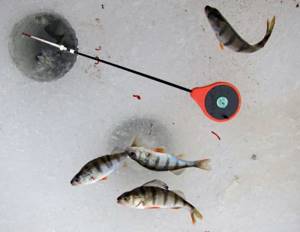
A heavy device that can create noise will force the perch to bite. The wiring is carried out in short amplitudes, holding the rod at the bottom for up to several seconds.
The effectiveness of fishing does not end when the weather warms up; before the end of the winter period, they become angry and hungry and rush to the bait. To do this, you will need small devices, since the perch is preparing to spawn and reacts poorly to large objects.
The first ice season is the most effective period for catching perch on the ice. On the first ice, the fish tries to gain strength after winter with increased nutrition.
A large increase in ice forces perch to move away from the shores; in frosty weather they hide in holes. For the rest of the time, the search for fish should be carried out in the upper boundaries of the banks on old channels.
Good weather for fishing is calm and windless, and the frost is slight but constant. It was not possible to determine what time of day is best for catching perches, since you can sit in the morning without a catch and only enjoy the result in the evening.
Mistakes you shouldn't make
Typical mistakes when fishing with balda in winter are excessive slack during pauses, when the weight falls on its side, dragging along the loop with hooks, which is why they do not move along the line and do not attract fish. The second common mistake is frequent swings, as when fishing with a spoon. Small pauses often prevent the hooks from descending all the way to the sinker.
If you haven’t fished with such wonderful tackle as the Balda yet, it’s time to try it. Balda often catches common baits and equipment in the most difficult situations.
Tactical actions for a successful catch
It is critical to find active fish, so if there are no bites, do not linger near one hole. Recesses are drilled, giving preference to edges, deep drops, and near bottom clutter with snags. The fishing line should be strong so as not to allow the perch to go under the rubble. In those holes where the bites began, additional holes are drilled in order to form a productive perimeter.
Observe the following rules:
- the bite begins in pauses from tapping on the bottom, in muddy water, it appears from smooth vibrations of the rod, raising and lowering the sinker;
- the water in the hole is disturbed at different levels, the boom is lowered to the lower, then to the upper point;
- make several sharp movements, raise the fishing rod so that the bait comes off the bottom, then goes deeper into the silt again, lowers it, moves it above the bottom surface;
- Having lowered the bulldozer to the end, they continue the game without lifting the tackle from the soil; the hooks will complete their work and lure the perch;
- move the bait near the bottom, then lift it, throw it again, freeze, and after a pause repeat the procedure;
- methods need to be changed until the most acceptable method is found at the moment.
A real fisherman is not afraid of experiments, selects combinations from several proven cases, and as soon as the bite follows, he secures his discovery for the place.
Correctly chosen point, correctly guessed time, competent game combination - these are the main points of successful perch fishing.
Specifics of fishing
The process of this fishing is quite simple. In the classic version, the tackle is lowered to the very bottom of the reservoir and with a sharp movement rises 15–20 cm. After a few seconds, the raised bait falls to the bottom again. As a result, a small cloud of turbidity rises, which attracts the predator. Seeing a bright moving object in it, the perch thinks that it has found its natural prey and falls for one of the hooks.
The specifics of fishing vary depending on the reservoir, depth, time of year and the personal experience of the fisherman. Over time, each fisherman begins to feel his game, easily varying both the number and speed of lifts, and the time the tackle is in the raised state.
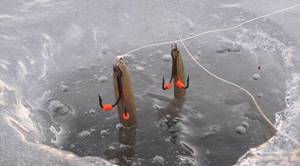
Features of ice fishing for perch on the Baldu
Features of catching perch in winter
Despite the versatility of the bait, the best time to use it is still winter. In cold, clear water, the tackle and the silt raised by it attract perch much more effectively.
However, winter fishing with this gear has a number of subtleties that are sometimes unknown to novice fishermen:
- Since competent ice fishing involves constant play with bait, the fisherman may be required to remain in one position in the cold for a long time. Therefore, you should take care of warm clothes, shoes and gloves in advance (it is advisable to have spare ones). Unfortunately, this obvious rule is neglected by many beginners.
- Perches travel in schools. Arriving at a frozen pond, the fisherman has no idea where exactly and at what moment a group of these predators will pass. Therefore, it is advisable to immediately drill several holes located at a distance of 3–4 meters from each other.
- At the initial stage, fishing is a kind of reconnaissance, the purpose of which is to find a cluster of perches. It is better to start the game from the hole closest to the shore and gradually change the location. At this stage, it is advisable to stay at each ice hole for no more than 10 minutes.
- As soon as active bites begin, the main thing is to immediately throw the tackle into the water again, since the flock may leave.
- This type of fishing is an alternation of long periods of waiting and bright moments when bites follow one after another. Therefore, you need to be prepared to spend a lot of time and effort searching for a pack of predators.
How to make a balda with your own hands
To produce a perch balda, it is better to prepare several plaster molds in order to cast lead sinkers of different weights and types into them.
Finished blanks:
- process it with a file, obtain the desired edge, round the top;
- step back from the pointed end by 3 mm, drill or pierce a hole with an awl;
- select hooks of the required sizes for each type of bulldozer; they should not be smaller than the body itself;
- each hook is equipped with cambrics and beads;
- the tackle is collected in a certain sequence onto a fishing line;
- the assembly is tied with a non-tightening knot.
For a universal rod that plays a role and spinners, you will need several points that are distinctive from the previous ones. With its help, perch are attracted during the game, the device must hit one point, this is typical for “powder”. The fisherman casts the tackle, and the bait, in a horizontal position, both lies on the water and goes down, without moving away from the edges of the depression. The boom descends, and at the same time, oscillates all the time, falling in a mirror image from the water surface to the bottom.

Scheme of the structure of the bulldozer for perch
Making such a design is quite simple; just connect a winter lure with two hooks. The body can be fixed with them either with a regular bulldozer or with wire “ears”.
☸ Making a bulldozer for winter fishing with your own hands
Now such bait is sold in fishing stores, but it is better to make it yourself, taking into account the preferences of the underwater inhabitants of the body of water on which it will be used. Moreover, the manufacturing process is no less interesting than the fishing itself. First, you need to cast a drop-shaped weight into a plaster mold, process the workpiece with a file and drill a through hole in the upper narrow part. The sinker is ready. Now you can start selecting hooks. In size they should not exceed the length of the lead weight - this is the only rule. Next, all the elements are put on the fishing line in the required order, and a small loop is made through which they will move freely. The loop must not be tightened. You can put on multi-colored beads (cambrics) both before and after installation. The bait is collected, you can go to the pond and check its effectiveness.
Important helpful tips
Ways to improve the bite:
- use of activators;
- design changes of baits;
- attracting perches with biological active substances - pheromones.
- Using bait (for perch - bloodworms).
It is important to provide:
- you should start fishing by making different types of bulldozer;
- when choosing hooks you need to focus on brilliant options;
- It’s hard to catch perch at night (and not only on the big fish);
- with this type of tackle you can do without bait, since the raised turbidity completely replaces it;
- fishing on a rock bottom reduces the effectiveness of fishing.

